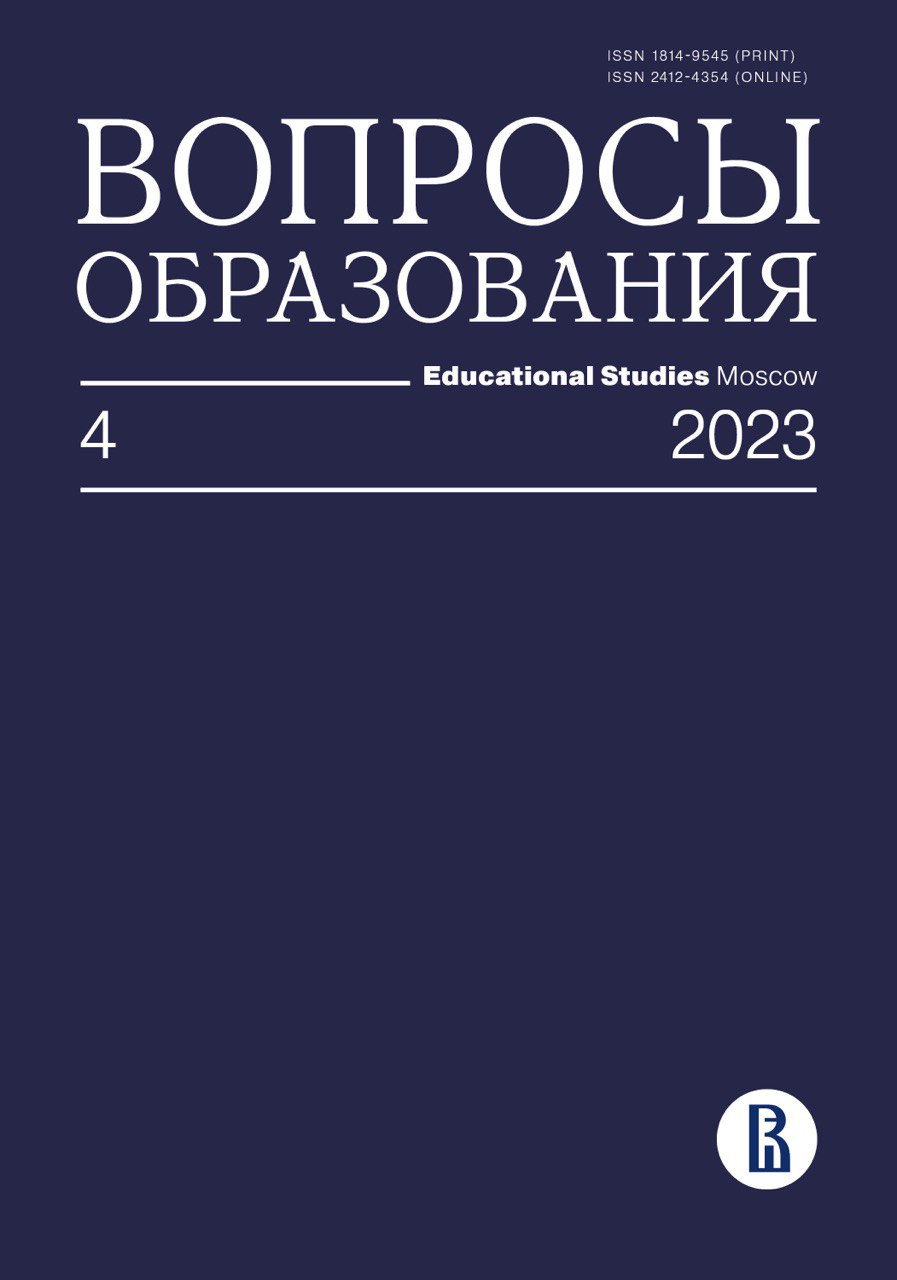Russian Youth Educational Choice Cultural Patterns: The Case of VET Choice
Abstract
The aim of the study is to explore how adolescents make sense of various educational opportunities while making educational decision to go to college after grade 9. We seek to decipher which symbolic horizons adolescents derive from in order to shape their decision irrespective of grades or family SES. To do so, we draw on data from in-depth interviews collected in 2013 as part of the Trajectories in Education and Careers project. We find that, on the one hand, decisions about the choice of trajectory are not made randomly, solely because of grades, but at the same time they are not only rational. As a result, we identify 4 symbolic horizons of decision-making, which indicates the heterogeneity of cultural patterns of decision-making to leave school and go to college.
Downloads
References
Aaltonen S., Karvonen S. (2016) Floating Downstream? Parental Support and Future Expectations of Young People from Less Privileged Backgrounds. Sociology, vol. 50, no 4, pp. 714–730. https://doi.org/10.1177/0038038515577907
Abramov R. (2019) Rabochie v sovremennykh sotsiologicheskikh issledovaniyakh: Rossijskiy kontekst [Working Class in the Current Sociological Studies: Russian Context]. Bulletin of Udmurt University. Sociology. Political Science. International Relations, vol. 3, no 3, pp. 283–291.] https://doi.org/10.35634/2587-9030-2019-3-3-283-291
Alexander J.C., Smith P. (2018) The Strong Program in Cultural Sociology: Meaning First. Routledge Handbook of Cultural Sociology (eds L. Grindstaff, M.-C.M. Lo, J.R. Hall), London, New York: Routledge, pp. 13–22. https://doi.org/10.4324/9781315267784-2
Arnett J.J. (2006) The Psychology of Emerging Adulthood: What Is Known, and What Remains to Be Known? Emerging Adults in America: Coming of Age in the 21st Century (eds J.J. Arnett, J.L. Tanner), Washington, DC: American Psychological Association, pp. 303–330. https://doi.org/10.1037/11381-013
Atkins L. (2017) The Odyssey: School to Work Transitions, Serendipity and Position in the Field. British Journal of Sociology of Education, vol. 38, no 5, pp. 641–655. https://doi.org/10.1080/01425692.2015.1131146
Ball S.J., Davies J., David M., Reay D. (2002) ‘Classification’ and ‘Judgement’: Social Class and the ‘Cognitive Structures’ of Choice of Higher Education. British Journal of Sociology of Education, vol. 23, no 1, pp. 51–72. https://doi.org/10.1080/01425690120102854
Bessudnov A., Malik V. (2016) Sotsial´no-ekonomicheskoe i gendernoe neravenstvo pri vybore obrazovatel´noy traektorii posle okonchaniya 9‑go klassa sredney shkoly [Socio-Economic and Gender Inequalities in Educational Trajectories upon Completion of Lower Secondary Education in Russia]. Voprosy obrazovaniya / Educational Studies Moscow, no 1, pp. 135–167. https://doi.org/10.17323/1814-9545-2016-1-135-167
Bessudnov A., Kurakin D., Malik V. (2017) Kak voznik i chto skryvaet mif o vseobshchem vysshem obrazovanii [The Myth about Universal Higher Education: Russia in the International Context]. Voprosy obrazovaniya / Educational Studies Moscow, no 3, pp. 83–109. https://doi.org/10.17323/1814-9545-2017-3-83-109
Boudon R. (1974) Education, Opportunity, and Social Inequality: Changing Prospects in Western Society. New York, NY: John Wiley & Sons.
Bourdieu P. (1986) Distinction. A Social Critique of the Judgement of Taste. London, New York: Routledge.
Bourdieu P., Passeron J.-C. (1990) Reproduction in Education, Society and Culture. London, Beverly Hills: Sage.
Bynner J. (2005) Rethinking the Youth Phase of the Life-Course: The Case for Emerging Adulthood? Journal of Youth Studies, vol. 8, no 4, pp. 367–384. https://doi.org/10.1080/13676260500431628
Delay C. (2022) Youngsters’ Choices within the Field of Vocational Education in French-Speaking Switzerland: The Interplay of Institutional Influences, Peer-Group and Habitus. Journal of Youth Studies, vol. 25, no 1, pp. 116–135. https://doi.org/10.1080/13676261.2020.1849583
Dolberg P., Amit K. (2023) On a Fast-Track to Adulthood: Social Integration and Identity Formation Experiences of Young-Adults of 1.5 Generation Immigrants. Journal of Ethnic and Migration Studies, vol. 49, no 1, pp. 252–271. https://doi.org/10.1080/1369183X.2022.2088484
France A., Threadgold S. (2016) Youth and Political Economy: Towards a Bourdieusian Approach. Journal of Youth Studies, vol. 19, no 5, pp. 612–628. https://doi.org/10.1080/13676261.2015.1098779
Furstenberg F.F. (2013) Transitions to Adulthood: What We Can Learn from the West. The ANNALS of the American Academy of Political and Social Science, vol. 646, no 1, pp. 28–41. https://doi.org/10.1177/0002716212465811
Geertz, C. (1973). The Interpretation of Cultures. Basic Books.
Gimpelson V.E., Zinchenko D.I. (2019) Tsena vozrasta: zarabotnaya plata rabotnikov v starshikh vozrastakh [Cost of Getting Older: Wages of Older Age Workers]. Voprosy Ekonomiki, no 11, pp. 35–62. https://doi.org/10.32609/0042-8736-2019-11-35-62
Hodkinson P. (2009) Understanding Career Decision Making and Progression: Careership Revisited: The Fifth John Killeen Memorial Lecture, October 2008. Journal of the National Institute for Career Education and Counselling, vol. 21, no 1, pp. 4–17. https://doi.org/10.20856/jnicec.2102
Hodkinson P. (1998) The Origins of a Theory of Career Decision‐Making: A Case Study of Hermeneutical Research. British Educational Research Journal, vol. 24, no 5, pp. 557–572. https://doi.org/10.1080/0141192980240505
Hodkinson P., Sparkes A.C. (1997) Careership: A Sociological Theory of Career Decision Making. British Journal of Sociology of Education, vol. 18, no 1, pp. 29–44. https://doi.org/10.1080/0142569970180102
Jackson M. (2013) Introduction: How Is Inequality of Educational Opportunity Generated? The Case for Primary and Secondary Effects. Determined to Succeed? Performance versus Choice in Educational Attainment (ed. M. Jackson), Stanford, CA: Stanford University, pp. 1–33. https://doi.org/10.11126/stanford/9780804783026.003.0001
Jones G. (2002) The Youth Divide: Diverging Paths to Adulthood. New York, NY: York Publishing Services for the Joseph Rowntree Foundation.
Khavenson T. E., Chirkina T.A. (2019) Obrazovatel'ny vybor uchashchikhsya posle 9-go i 11-go klassov: sravnenie pervichnykh i vtorichnykh effektov social'no-ekonomicheskogo polozheniya sem'i [Student Educational Choice after the 9th and 11th Grades: Comparing the Primary and Secondary Effects of Family Socioeconomic Status]. The Journal of Social Policy Studies, vol. 17, no 4, pp. 539–554. https://doi.org/10.17323/727-0634-2019-17-4-539-554
Khavenson T. E., Chirkina T.A. (2018) Effektivno podderzhivaemoe neravenstvo. Vybor obrazovatel'noy traektorii posle 11-go klassa shkoly v Rossii [Effectively Maintained Inequality. The Choice of Postsecondary Educational Trajectory in Russia]. Ekonomicheskaya sotsiologiya / Journal of Economical Sociology, vol. 19, no 5, pp 66–89. https://doi.org/10.17323/1726-3247-2018-5-66-89
Konstantinovskiy D.L. (2008) Neravenstvo i obrazovanie. Opyt sotsiologicheskikh issledovaniy zhiznennogo starta rossijskoy molodezhi (1960-e gody — nachalo 2000-h) [Inequality and Education. The Experience of Sociological Studies of the Life Start of Russian Youth (1960s — Early 2000s)]. Moscow: Center for social forecasting.
Konstantinovskiy D.L., Popova E.S. (2020) Srednee vs vysshee [Vocational vs Higher Education]. Universe of Russia, vol. 29, no 2, pp. 6–26. https://doi.org/10.17323/1811-038X-2020-29-2-6-26
Konstantinovskiy D.L., Popova E.S. (2018) Rossiyskoe srednee professional'noe obrazovanie: vostrebovannost' i spetsifika vybora [Russian Secondary Professional Education: Demand and Specificity of Choice]. Sotsiologicheskie Issledovaniia / Sociological Studies, no 3, pp. 34–44. https://doi.org/10.7868/S0132162518030030
Kosyakova Y., Yastrebov G., Yanbarisova D., Kurakin D. (2016) The Reproduction of Social Inequality within the Russian Educational System. Models of Secondary Education and Social Inequality: An International Comparison (eds S. Buchholz, H.-P. Blossfeld, J. Skopek), Cheltenham / Northampton: Edward Elgar, pp. 323–342. https://doi.org/10.4337/9781785367267.00031
Kurakin D. (2020) Tragediya neravenstva: raschelovechivaya «total'nogo cheloveka» [Tragedy of Inequality: Dehumanizing “L’Homme Total”]. Russian Sociological Review, vol. 19, no 3, pp. 167–231. http://dx.doi.org/10.17323/1728-192x-2020-3-167-231
Laughland-Booÿ J., Mayall M., Skrbiš Z. (2015) Whose Choice? Young People, Career Choices and Reflexivity Re-Examined. Current Sociology, vol. 63, no 4, pp. 586–603. https://doi.org/10.1177/0011392114540671
Lareau A. (2003) Unequal Childhoods: Class, Race, and Family Life. Berkeley: University of California Press.
Lehmann W. (2004) ‘For Some Reason, I Get a Little Scared’: Structure, Agency, and Risk in School–Work Transitions. Journal of Youth Studies, vol. 7, no 4, pp. 379–396. https://doi.org/10.1080/1367626042000315185
Maltseva V.A., Salnikova I.Y., Shabalin A. I. (2022) Vmesto universiteta — v kolledzh: chto privodit uspevayushchikh odinnadtsatiklassnikov v SPO? [Vocational School Instead of a University: What Brings Successful Eleventh-Graders to Vocational Education?] Monitoring of Public Opinion: Economic and Social Changes, no 3, pp. 45–66. https://doi.org/10.14515/monitoring. 2022.3.2090
Maltseva V.A., Shabalin A.I. (2021) Ne-obkhodnoy manevr, ili Bum sprosa na sred-nee professional’noe obrazovanie v Rossii [The Non-Bypass Trajectory, or The Boom in Demand for TVET in Russia]. Voprosy obrazovaniya / Educational Studies Moscow, no 2, pp. 10–42. https://doi.org/10.17323/1814-9545-2021-2-10-42
Roberts S. (2012) One Step Forward, One Step Beck: A Contribution to the Ongoing Conceptual Debate in Youth Studies. Journal of Youth Studies, vol. 15, no 3, pp. 389–401. https://doi.org/10.1080/13676261.2012.663896
Roberts S. (2010) Misrepresenting ‘Choice Biographies’? A Reply to Woodman. Journal of Youth Studies, vol. 13, no 1, pp. 137–149. https://doi.org/10.1080/13676260903233720
Schoon I. (2015) Diverse Pathways: Rethinking the Transition to Adulthood. Families in an Era of Increasing Inequality: Diverging Destinies (eds P.R. Amato, A. Booth, S.M. McHale, J. van Hook), Cham: Springer International Publishing, pp. 115–136. https://doi.org/10.1007/978-3-319-08308-7_9
Silva J.M., Corse S.M. (2018) Envisioning and Enacting Class Mobility: The Routine Constructions of the Agentic Self. American Journal of Cultural Sociology, vol. 6, no 2, pp. 231–265. https://doi.org/10.1057/s41290-017-0026-x
Sobotka A. (2021) Social Differences in Making Educational Choices on Higher Education in Poland. Italian Journal of Sociology of Education, vol. 13, no 1, pp. 71–94. https://doi.org/10.14658/pupj-ijse-2021-1-4
Tartakovskaya I., Van'ke A. (2016) Kar'era rabochego kak biograficheskiy vybor [Working-Class Career as Choice Biography]. Russian Sociological Review, vol. 15, no 3, pp. 9–48. https://doi.org/10.17323/1728-192X-2016-3-9-48
Threadgold S., Nilan P. (2009) Reflexivity of Contemporary Youth, Risk and Cultural Capital. Current Sociology, vol. 57, no 1, pp. 47–68. https://doi.org/10.1177/0011392108097452
Walker C. (2010) Learning to Labour in Post-Soviet Russia. Vocational Youth in Transition. London: Routledge. https://doi.org/10.4324/9780203837870
Walker C. (2007) Navigating a ‘Zombie’ System: Youth Transitions from Vocational Education in Post‐Soviet Russia. International Journal of Lifelong Education, vol. 26, no 5, pp. 513–531. https://doi.org/10.1080/02601370701559607
Yastrebov G., Kosyakova Y., Kurakin D. (2018) Slipping Past the Test: Heterogeneous Effects of Social Background in the Context of Inconsistent Selection Mechanisms in Higher Education. Sociology of Education, vol. 91, no 3, pp. 224–241. https://doi.org/10.1177/0038040718779087
Zerubavel E. (1993) Horizons: On the Sociomental Foundations of Relevance. Social Research, vol. 60, no 2, pp. 397–413.









